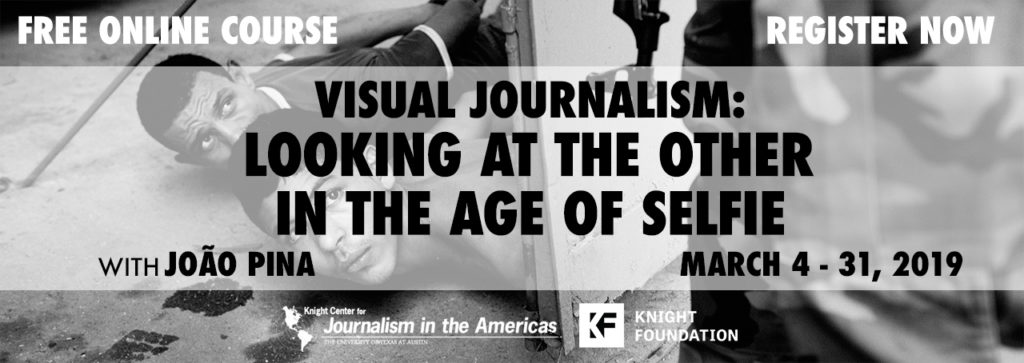
An ever-increasing number of people have powerful tools in their pockets or purses that can document the world around them. However, much of the time, the lenses of our phones or cameras are focused on ourselves. The latest course from the Knight Center for Journalism in the Americas will show how to get out of selfie mode to tell other people’s stories through documentary photography.
The free online course “Visual Journalism: Looking at the other in the age of selfie” will be taught by celebrated and award-winning photographer João Pina from March 4 to 31, 2019. Register now!
“Students will learn history of photojournalism, its ethical standards and how to have a critical eye while looking and making photographs in the digital age,” Pina explained.
“We are delighted to have a master in documentary photography, who is internationally recognized, teaching a massive open online course (MOOC) for us,” said professor Rosental Alves, founder and director of the Knight Center for Journalism in the Americas. “We all have cameras in our pockets, cell phone cameras are better every day, so now we all need to better understand the art of photography, the tricks of photojournalism, its ethics, its history.”
Pina will approach the course by studying the humanistic tradition towards photography with deep roots in the early 20th century. He will also be joined by special guest speakers each week including: James Wellford, senior photo editor for National Geographic Magazine; Diana Markosian, Magnum photographer; Stephen Ferry, an American photographer based in Colombia; and Adriana Zehbrauskas, a Brazilian photographer based in Arizona, U.S.
The course will be divided into four weekly modules:
Each module consists of video lectures, readings, photographic assignments, quizzes and participation in discussion forums. Like all Knight Center courses, this MOOC is asynchronous, so students can complete the activities during the days and times that are most convenient. However, there are suggested deadlines so you don’t fall behind.
Instructor João Pina is a Portuguese freelance photographer whose work has been published in international media and exhibited across the world. His photos have been published in D Magazine, Days Japan, El País, Expresso, GEO, La Vanguardia, The New York Times, The New Yorker, Newsweek, Stern, Time and Visão, among other media.
He has published three books, the first of which, “Por Teu Livre Pensamento,” inspired an advertising campaign from Amnesty International for which he won a Gold Lion Award. He also published “CONDOR” about the large-scale operation carried out by right-wing militarty dictatorships in Latin America in 1975, and “46750,” about urban violence and the transformation of Rio de Janeiro leading up to the World Cup and Olympic Games. The latter book’s title represents the number of homicides in the Rio de Janeiro metro area between 2007 and 2016. He won the Estação Imagem grant and was a Nieman Fellow at Harvard University. Pina is a faculty member at the International Center of Photography in New York and a regular lecturer and photography workshop teacher.
The course is open to all visual journalists and anyone interested in photojournalism and documentary photography. Students should also want to learn new ways of reaching audiences through social media and traditional media.
To successfully participate in the course, students will need Internet access and access to a digital camera or a phone with a built-in camera.
The course is free, thanks to a generous grant from the John S. and James L. Knight Foundation that has helped the Knight Center to offer journalism training for journalists from around the world. However, students who successfully complete course requirements and have the option of paying an administrative fee of U.S. $30 to receive a certificate of completion in PDF format. No formal college credit is associated with the certificate.
Register now and be on your way to learning how visual journalism can be used to tell the stories of the world around us.
About the John S. and James L. Knight Foundation
The Knight Foundation is a national foundation with strong local roots that invests in journalism, the arts and in the success of cities where brothers John S. and James L. Knight once published newspapers. Its goal is to foster informed and engaged communities, which it believes are essential for a healthy democracy. For more, visit kf.org.
About the Knight Center
The Knight Center for Journalism in the Americas was created in 2002 by Professor Rosental Alves, Knight Chair of Journalism at the Moody College of Communication at the University of Texas, thanks to the generous donations of the John S. and James L. Knight Foundation. The Knight Center’s distance learning program began in 2003 and is funded in part by the Knight Foundation. Over the past six years, the Knight Center MOOCs have reached more than 170,000 people in 200 countries and territories.
